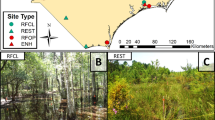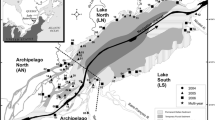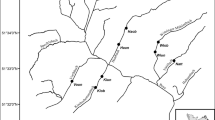Abstract
Despite the mandate of the Clean Water Act to protectthe physical, chemical, and biological integrity ofthe USA's wetlands, the use of biota to assess wetlandcondition has not been well explored. During June,1996, we evaluated the response of macroinvertebrateassemblages to fill-culvert highway crossings in twobottomland forested wetlands in North Carolina. Ourobjective was to apply biological assessment methodsand metrics that have been effectively used in streamsto explore their applicability in forested wetlands.We found significant changes in several metrics as afunction of distance from the highway crossings. Arealand numerical taxon richness increased within at least40 m of highway when compared to control locations.Percent dominant taxon values were lowest within 10 mof the highway. Percent herbivores also increasedsignificantly within at least 40 m of the highway,reflecting the lower % crown closure and associatedshift in primary production from trees to herbaceousmacrophytes and algae. The North Carolina BioticIndex, a metric of tolerance, did not reflectassemblage changes near the highway. Ordination andpermutation tests revealed that assemblage compositionwas significantly different from controls at 10 and 40 mdistances from the highway crossings. In particular,algal grazers such as the mayflies Caenissp.and Callibaetissp. responded positively and thedamselflies Ischnuraspp. and the fingernailclams Sphaeriumspp. responded negatively to thecrossings. Favorable algal and herbaceous detritalresources, greater patchiness and habitat complexity,and overall high tolerance to natural stressorsprobably contributed to the increase in taxon richnessnear the highway. However, significant deviation fromcontrol locations indicated the highway was a sourceof perturbation. Our findings illustrate the potentialutility of macroinvertebrate assemblages for wetlandassessment, but suggest the importance of defining thereference condition as well as the need fordevelopment of metrics for specific classes ofwetlands.
Similar content being viewed by others
References
Adamus, P.R. 1983. A method for wetland functional assessment. Volume I. U.S. Department of Transportation, Federal Highway Administration, Office of Research and Development, Washington, DC, USA. Report No. FHWA-IP-82-83.
Adamus, P.R. and Stockwell, L.T. 1983. A method for wetland functional assessment. Volume II. U.S. Department of Transportation, Federal Highway Administration, Office of Research and Development, Washington, DC, USA. Report No. FHWA-IP-82-83.
Barbour, M.T. and Gerritsen, J. 1996. Subsampling of benthic samples: a defense of the fixed-count method. J. N. Am. Benthol. Soc. 15: 386–391.
Barbour, M.T., Gerritsen, J., Griffith, G.E., Frydenborg, R., McCarron, E., White, J.S. and Bastian, M.L. 1996. A framework for biological criteria for Florida streams using benthic macroinvertebrates. J. N. Am. Benthol. Soc 15: 185–211.
Batzer, D.P. and Wissinger, S.A. 1996. Ecology of insect communities in nontidal wetlands. Ann. Rev. Entomol. 41: 75–100
Beck, L.T. 1977. Distribution and relative abundance of freshwater macroinvertebrates of the lower Atchafalaya River Basin, Louisiana. M.S. Thesis, Louisiana State University, Baton Rouge, LA, USA.
Benke, A.C., Van Arsdall, T.C. and Gillespie, D.M. 1984. Invertebrate productivity in a subtropical blackwater river: the importance of habitat and life history. Ecol. Monogr. 54: 25–63.
Brigham, A.R., Brigham, W.U. and Gnilka, A. (eds.). 1982. Aquatic Insects and Oligochaetes of North and South Carolina. Midwest Aquatic Enterprises, Mahomet, IL, USA.
Brinkhurst, R.O. 1986. Guide to the Freshwater Microdrile Oligochaetes of North America. Canadian Special Publication of Fisheries and Aquatic Sciences 84.
Brinson, M.M. and Rheinhardt, R. 1996. The role of reference wetlands in functional assessment and mitigation. Ecol. Appl. 6: 69–76.
Brown, C.L., Poe, T.P., French, J.R. and Schloesser, D.W. 1988. Relationships of phytomacrofauna to surface area in naturally occurring macrophyte stands. J. N. Am. Benthol. Soc. 7: 129–139.
Cheal, F., Davis, J.A., Growns, J.E., Bradley, J.E. and Whittles, F.H. 1993. The influence of sampling method on the classification of wetland macroinvertebrate communities. Hydrobiologia 257: 47–56.
Clark, J.R. and Benforado, J. (eds.). 1981. Wetlands of Bottomland Hardwood Forests. Elsevier, New York, NY, USA.
Clarke, K.R. 1993. Non-parametric multivariate analyses of changes in community structure. Austral. J. Ecol. 18: 117–143.
Cooper, C.M. 1987. Benthos in Bear Creek, Mississippi (USA): Effects of habitat variation and agricultural sediments. J. Freshwater Ecol. 4: 101–114.
Ellis, J.I. and Schneider, D.C. 1997. Evaluation of a gradient sampling design for environmental impact assessment. Environ. Monit. Assess. 48: 157–172.
Epler, J.H. 1995. Identification Manual for the Larval Chironomidae of Florida, Revised Edition. Florida Department of Environmental Protection, Tallahassee, FL, USA.
Epler, J.H. 1996. Identification Manual for the Water Beetles of Florida. Florida Department of Environmental Protection, Tallahassee, FL, USA.
Faith, D.P., Minchin, P.R. and Belbin, L. 1987. Compositional dissimilarity as a robust measure of ecological distance. Vegetatio 69: 57–68.
Florida Department of Environmental Protection (FDEP). 1996. Standard operating procedures manual-benthic macroinvertebrate sampling and habitat assessment methods: 1. Freshwater streams and rivers. Florida Department of Environmental Protection, Tallahassee, FL, USA.
Growns, J.E., Chessman, B.C., Jackson, J.E. and Ross, D.G. 1997. Rapid assessment of Australian rivers using macroinvertebrates: cost and efficiency of 6 methods of sample processing. J. N. Am. Benthol. Soc. 16: 682–693.
Haynes, J.M. and Markarewicz, J.C. 1982. Comparison of benthic communities in dredged and undredged areas of the St. Lawrence River, Cape Vincent, New York, USA. Ohio J. Sci. 82: 165–170.
Hilsenhoff, W.L. 1987. An improved biotic index of stream pollution. Great Lakes Entomol. 20: 31–39.
Huggins, D.G. and Brigham, W.U. 1982. Odonata. In: Brigham, A.R., Brigham, W.U. and Gnilka, A. (eds.) Aquatic Insects and Oligochaetes of North and South Carolina. pp. 4.1–100. Midwest Aquatic Enterprises, Mahomet, IL, USA.
Hurlbert, S.H. 1971. The nonconcept of species diversity: a critique and alternative parameters. Ecology 52: 577–586.
Karr, J.R. and Chu, E.W. 1997. Biological monitoring and assessment: using multimetric indexes effectively. University of Washington, Seattle, WA, USA. EPA 235-R97-001.
Kerans, B.L. and Karr, J.R. 1994. A benthic index of biotic integrity (B-IBI) for rivers of the Tennessee Valley. Ecol. Appl. 4: 768–785.
Kobriger, N.P., Dupuis, T.V., Kreutzberger, W.A., Stearns, F., Guntenspergen, G. and Keough, J.R. 1983. Guidelines for the management of highway runoff on wetlands. Transportation Research Board, National Research Council, Washington DC, USA. National Cooperative Highway Research Program Report 264.
Kusler, J. and Niering, W. 1998. Wetland assessment: Have we lost our way? National Wetlands Newsletter 20: 8–14.
Larsen, D.P. and Herlihy, A.T. 1998. The dilemma of sampling streams for macroinvertebrate richness. J. N. Am. Benthol. Soc. 17: 359–366.
Lenat, D.R. 1988. Water quality assessment of streams using a qualitative collection method for benthic macroinvertebrates. J. N. Am. Benthol. Soc. 7: 222–233.
Lenat, D.R. 1993. A biotic index for the southeastern United States: derivation and list of tolerance values, with criteria for assigning water quality ratings. J. N. Am. Benthol. Soc 12: 279–290.
Ludwig, J.A. and Reynolds, J.F. 1988. Statistical Ecology. John Wiley and Sons, New York, NY, USA.
McCune, B. and Mefford, M.J. 1997. Multivariate Analysis of Ecological Data, Version 3.18. MjMSoftware, Gleneden Beach, OR, USA.
Merritt, R.W. and Cummins, K.W. (eds.). 1996. An Introduction to the Aquatic Insects of North America, 3rd edn. Kendall/Hall, Dubuque, IA, USA.
Mielke, P.W., Berry, K.J. and Brier, G.W. 1981. Application of multi-response permutation procedures for examining seasonal changes in monthly mean sea-level pressure patterns. Monthly Weather Review 109: 120–126.
Minchin, P.R. 1994. Database for Ecological COmmunity DAta (DECODA), version 2.05. University of Melbourne, Parkville, Victoria, Australia.
North Carolina Division of Water Quality (NCDWQ). 1997. Standard operating procedures, biological monitoring. North Carolina Department of Environment and Natural Resources, Raleigh, NC, USA.
Nunnery, K.T. 1997. An assessment of highway impacts on ecological function in palustrine forested wetlands in the upper coastal plain of North Carolina. Ph.D. Dissertation, Duke University, Durham, NC, USA.
O'Connor, N.A. 1991. The effect of habitat complexity on the macroinvertebrates colonising wood substrates in a lowland stream. Oecologia 85: 504–512.
Odum, E.P., Finn, J.T. and Franz, E.H. 1979. Perturbation theory and the subsidy-stress gradient. BioScience 29: 349–352.
Oliver, I. and Beattie, A.J. 1996. Invertebrate morphospecies as surrogates for species: a case study. Conserv. Biol. 10: 99–109.
Omernik, J.M. 1987. Ecoregions of the conterminous United States. Annal. Assoc. Am. Geograph. 77: 118–125.
Paine, D.P. 1981. Aerial Photography and Image Interpretation for Resource Management. John Wiley and Sons, New York, NY, USA.
Parsons, K. and Wharton, C.H. 1978. Macroinvertebrates of pools on a Piedmont river floodplain. Georgia J. Sci. 36: 25–33.
Plafkin, J.L., Barbour, M.T., Porter, K.D., Gross, S.K. and Hughes, R.M. 1989. Rapid bioassessment protocols for use in streams and rivers: benthic macroinvertebrates and fish. United States Environmental Protection Agency, Washington, DC, USA. EPA/440/4-89/001.
Reynoldson, T.B., Norris, R.H., Resh, V.H., Day, K.E. and Rosenberg, D.M. 1997. The reference condition: a comparison of multimetric and multivariate approaches to assess water-quality impairment using benthic macroinvertebrates. J. N. Am. Benthol. Soc 16: 833–852.
Rheinhardt, R.D., Rheinhardt, M.C., Brinson, M.M. and Faser, K. 1998. Forested wetlands of low order streams in the inner coastal plain of North Carolina, USA. Wetlands 18: 365–378.
Richardson, C.J. and Nunnery, K.T. 1998. Field investigations of wetland functions after disturbance at the ecosystem level. In: Combs, A.J. and Davis, J.A. (eds.), Wetlands for the Future: Contributions from INTECOL's V International Wetlands Conference, pp. 359–372. Gleneagles, Adelaide, Australia.
Rosenberg, D.M. and Resh, V.H. (eds.). 1993. Freshwater Biomonitoring and Benthic Macroinvertebrate. Chapman and Hall, New York, NY, USA.
Rossiter, J.A. and Crawford, R.D. 1983. Evaluation of artificial wetlands in North Dakota: recommendations for future design and construction. Transport. Res. Record 948: 21–25.
Smock, L.A., Gillinsky, G.M. and Stoneburner, D.L. 1985. Macroinvertebrate production in a southeastern United States blackwater stream. Ecology 66: 1491–1503.
Smock, L.A., Metzler, G.M. and Gladden, J.E. 1989. Role of debris dams in the structure and functioning of low-gradient headwater streams. Ecology 70: 764–775.
Statsoft, Inc. 1998. STATISTICA for Windows, '98 edition. Statsoft, Inc., Tulsa, OK, USA.
Thorp, J.H. and Covich, A.P. 1991. Ecology and Classification of North American Freshwater Invertebrates. Academic Press, San Diego, CA, USA.
Thrasher, M.H. 1983. Highway impacts on wetlands: assessment, mitigation, and enhancement measures. Transport. Res. Record 948: 17–20.
Titmus, G. 1979. Distribution and behaviour of adult Chironomidae (Dipt.). Entomol. Monthly Mag. 115: 145–148.
Turner, A.M. and Trexler, J.C. 1997. Sampling aquatic invertebrates from marshes: evaluating the options. J. N. Am. Benthol. Soc. 16: 694–709.
United States Environmental Protection Agency (USEPA). 1997a. Wetlands: biological assessment methods and criteria development workshop. Proceedings, September 18-20, 1996, Boulder, CO, USA. EPA 843-3-97-001.
United States Environmental Protection Agency (USEPA). 1997b. Field and laboratory methods for macroinvertebrate and habitat assessment of low gradient, nontidal streams. Mid-Atlantic Coastal Streams Workgroup, Environmental Services Division, Region 3, Wheeling, WV, USA.
Wharton, C.H., Lambour, V.W., Newsom, J., Winger, P.V., Gaddy, L.L. and Mancke, R. 1981. The fauna of bottomland hardwoods in southeastern United States. In: Clark, J.R. and Benforado, J. (eds.), Wetlands of Bottomland Hardwood Forests. pp. 87–160. Elsevier, New York, NY, USA.
Wilson, D.M., Naimo, T.J., Wiener, J.G., Anderson, R.V., Sandheinrich, M.B. and Sparks, R.E. 1995. Declining populations of the fingernail clam Musculium transversum in the upper Mississippi River. Hydrobiologia 304: 209–220.
Zimmerman, G.M., Goetz, H. and Mielke, P.W. 1985. Use of an improved statistical method for group comparisons to study effects of prairie fire. Ecology 66: 606–611.
Author information
Authors and Affiliations
Rights and permissions
About this article
Cite this article
King, R., Nunnery, K. & Richardson, C. Macroinvertebrate assemblage response to highway crossings in forested wetlands: implications for biological assessment. Wetlands Ecology and Management 8, 243–256 (2000). https://doi.org/10.1023/A:1008479316066
Issue Date:
DOI: https://doi.org/10.1023/A:1008479316066




